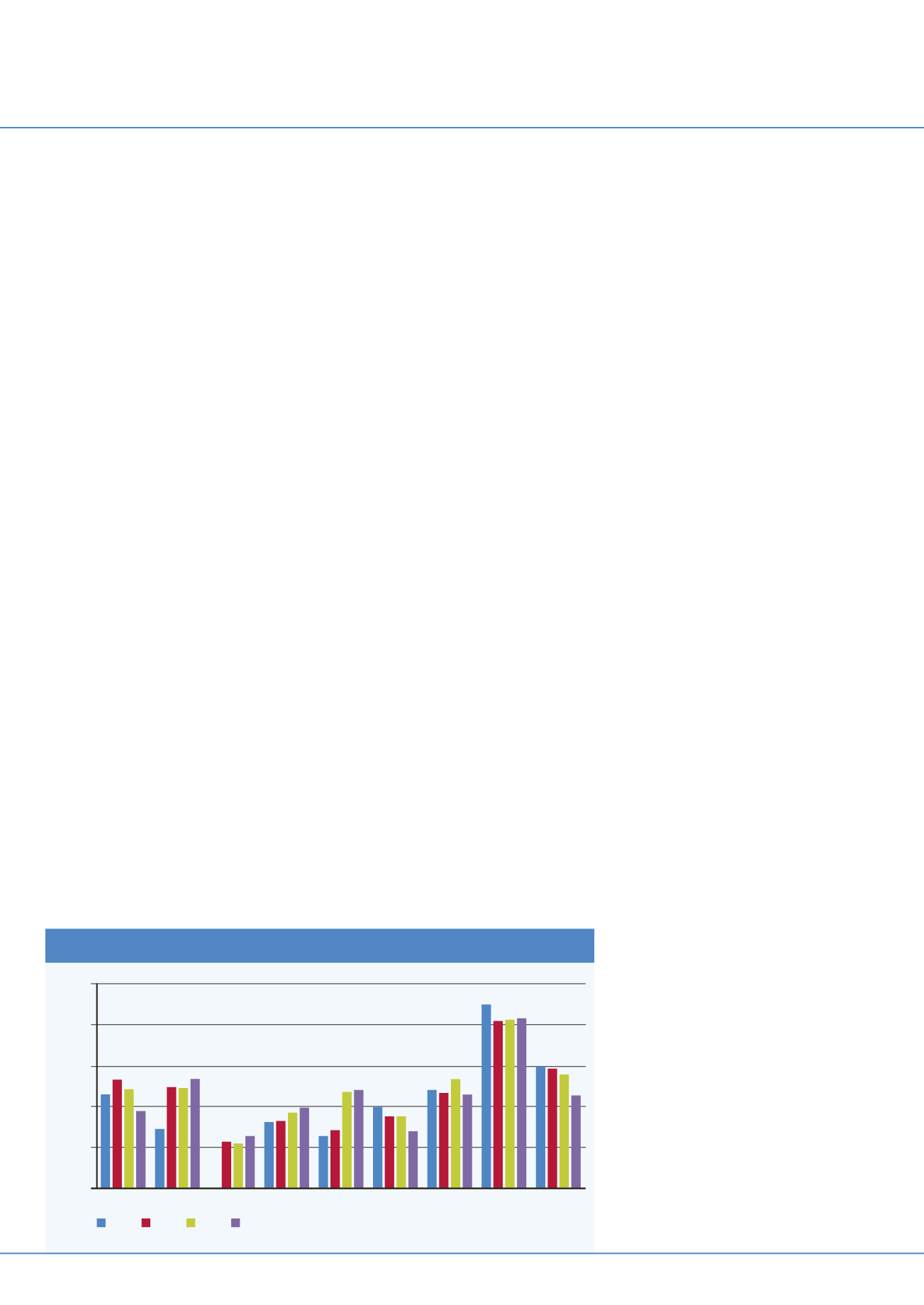
17
ECONOMICOUTLOOK
Investment growth
october 2014
international
construction
>
Investment growth
High oil prices are driving construction growth in theMiddle East, and there is a strong forecast for
the region despite conflicts and geopolitical instability.
Scott Hazelton
reports.
T
he economic outlook for the Middle East
is clouded by regional political instability,
including the Islamic State’s attacks in Iraq,
the Israeli-Palestinian conflict and Syria’s long
civil war.
On thepositive side, Iran’seconomy is stabilising
after two years of contraction, despite ongoing
sanctions on the energy andfinancial sectors.
The region depends on oil revenues and the
construction market is even more attuned to oil
prices than the overall economy.The continuing
boom in US oil production, combined with a
cooling Chinese economy, is restraining prices,
and crude oil prices are likely todecrease in2015.
However, global spare capacity will remain
tight, with little cushion to absorb additional
disruptions. Also, while North American supply
growth is strong, other potential new sources
(Iraq, Brazil, andKazakhstan) face hurdles.
Geopolitical tensions, not only in Iraq and
Syria,but alsoUkraine,Libya,Venezuela,Nigeria,
SouthSudanandYemen, continue topose further
upside price risks.
The overall effect in theMiddle East will be for
solid growth in regional GDP growth. Indeed,
the slowing growth of many emerging markets
means theMiddleEast is set tobe the third fastest
growing region, behind Asia (excluding Japan)
and sub-Saharan Africa. The Middle East also
offers a bigger market and less investment risk
than sub-SaharanAfrica.
Within theMiddleEast, the linkbetweenhigher
per capita income and lower investment risk
holds. The highest risks are in poorer countries
like Syria, Lebanon and Jordan, while the richer
countries, such as SaudiArabia and theUAEoffer
investment riskon a parwithwestern economies.
SaudiArabia, the largest economy in the region,
will sustain+4.5%GDPgrowthover thenextfive
years, as oil revenues support strong government
spending and investment.TheUAEwill perform
nearly as well, with GDP growth accelerating
modestly in both economies as oil prices slowly
rise.
Regional stability
For most of the region’s economies, plans for job
creation, economic diversification and greater
competitiveness will aid construction markets,
and is crucial to regional stability over the
medium term.
The graph for total construction indicates the
effect of a recovering regional economy and stable
oil prices. In general, 2014 is looking better
than 2013, and 2015 offers more potential than
2014. Flat oil prices will hold regional growth
steady, but the historically weaker markets, such
as Bahrain and Jordan, will improve while the
stronger markets such as Saudi Arabia andQatar
see somedecelerationbut remain regional leaders.
Over the next five years, total construction
spending in the Middle East will increase at an
annual rate of about +4.5% in real terms.
This is quite similar across structure types for
the region, with residential markets performing
lesswell and infrastructure faringbetter, although
there is more significant variation within
individual countries.
Over the next five years, Qatar offers the
strongest construction market growth at +7.1%
in real terms. SaudiArabia is a close secondwith a
rate of +6.0%, but its construction sector is twice
the size ofQatar’s.
This strong growth for Saudi Arabia represents
a slight slowing from the past five years, where it
had accelerated housing and similar programs to
mitigate unrest from theArab Spring.
Saudi positivity in themedium term is oriented
toward infrastructure. A key driver of this is the
US$ 22.5 billion metro project in Riyadh over
the next five years.Work has started on a system
that includes 85 train stations on sixmetro lines
totalling 176 km.
Growth inQatar
Qatar’s growth is more remarkable in that it is
a turnaround from the previous five years when
construction spending contracted.
The need to prepare for the 2022 FIFA
World Cup will drive venue and infrastructure
construction spending on top of the country’s
ambitious energy infrastructure improvements.
The challenge for Qatar will be prioritising
projects to avoid overheating the construction
economy.Qatar lacks a significantmanufacturing
base and most building materials need to be
imported. The country also lacks the port
capabilities ofDubai,UAE, for example.
There is also competition for labour with the
other fast growingGCC countries, butQatar has
still made a strong start on stadium construction
for theWorldCup.
While this means that some stadiums will not
bebrandnew for the2022 event, ithelps level out
infrastructure investment while demonstrating
progress to those sceptical of its ability to deliver.
Hence IHS Global Insight’s view of a gradually
accelerating constructionmarket through2019.
TheUAE is also forecast to performwell.With
its economic turnaround nearly complete, Dubai
is investing in a variety of projects, including
new industrial cities, airport terminals, hospitals,
schools and thousands of newhomes.
Retail sales are performing well, and new
retail space is also being planned. Dubai Land
Development has announced plans for ‘The
Perfect City’, which is intended to be 100%
sustainable and feature 75% green space,
including 20,000 trees.
Indeed, announced projects for Dubai tend to
be more ‘horizontal’ than ‘vertical’ as developers
Total construction
UAE
2013 2014 2015 2016
Iran
Jordan
Oman
Bahrain
Israel
Kuwait
Qatar Saudi Arabia
10%
8%
6%
4%
2%
0%


